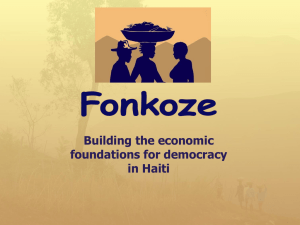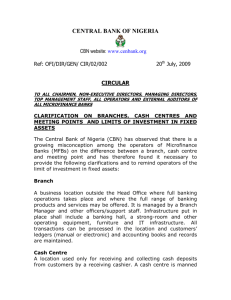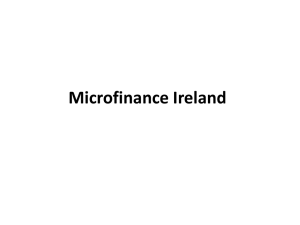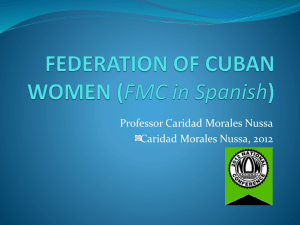Pavel Vidal: Microfinance in Cuba
advertisement
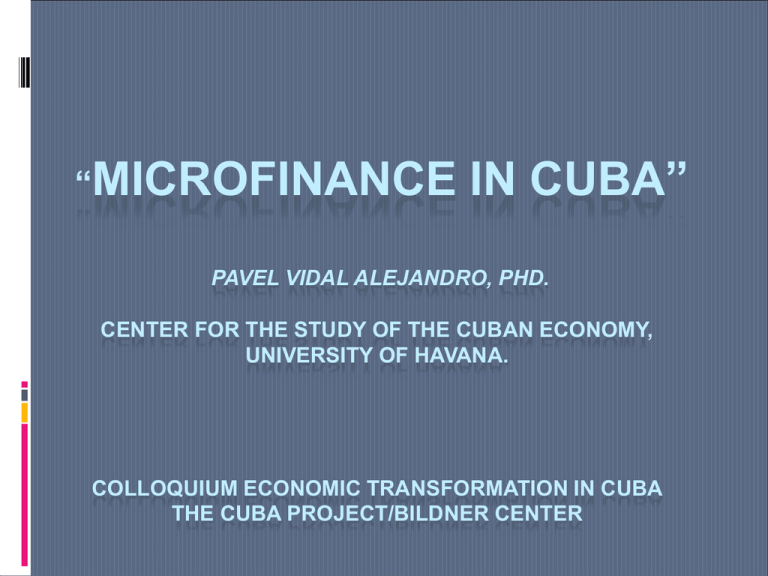
“MICROFINANCE IN CUBA” PAVEL VIDAL ALEJANDRO, PHD. CENTER FOR THE STUDY OF THE CUBAN ECONOMY, UNIVERSITY OF HAVANA. COLLOQUIUM ECONOMIC TRANSFORMATION IN CUBA THE CUBA PROJECT/BILDNER CENTER Introduction • A central piece of the current reform of the Cuban economic model is the creation of alternative spaces for small-scale private sector and cooperatives, besides the agricultural sector where they already existed. • Since 2011, there is a new credit policy for those economic actors. Presentation outline 1. The new credit policy 2. Impacts and challenges Cuban financial system • Previous banking reform in the 1990s. Central Bank 8 state-owned commercial banks 1 mixed bank 9 state-owned nonbank financial institutions 14 representation offices of foreign financial institutions • Since the 1990s banks gained autonomy in the selection of customers, risk management and credit decisions; under certain parameters and general credit policy defined by the Central Bank. Credit policy in 1990s and 2000s • Self-employed individuals have never had access to credit, and private farmers have had very limited access. • Credit for consumption was very restricted. New credit policy since 2011 Open up credit and financial services for non-state enterprises Open up credit for consumption Self-employers and micro businesses Repairs and construction of houses Private farmers Consumer goods, cars and home purchases Non-agricultural cooperatives Other non-state businesses authorized in the future Credit for private farmers increased 84% in 2010 and 11.3% in 2011 (up to March) 90% of the remaining new credit demand has been for repairing homes. Only 10% for self-employers and micro businesses Characteristics of the new credits Interest rates Amount and terms Collaterals • The Central Bank establishes a range for interest rates depending on credit purpose and term. • The range goes from 4.25% to 9%. • There is no upper limit for the loan amounts, only minimum. • The maximum term is 5 years. • Bank deposits of the applicant or of a third party, moveable goods, future incomes, others • Mortgages of permanent home are not allowed. Three banks will address these credits: BANDEC, BPA and Banco Metropolitano Potential positive impacts • New financial resources for private business. • A proliferation of informal finance would be avoided. • Increased efficiency in the allocation of financial resources. • Reinforce the credit mechanisms and the domestic market as driver of economic growth. • Reduce operational costs of private businesses and make viable their links with state enterprises. • Facilitate legal control, particularly fiscal evasion. The challenges of microfinance • The new credit policy in Cuba can be classified as an opening in favor of microloans and microfinance. • International microfinance faces challenges in many aspects: - scope - cost - collateral - technology - banking supervision - the actual goal and sustainability - the roll of public banks - others • Cuba will have to deal with some or all of them. Institutional and structural weaknesses • Cuban banks have little experience in microfinance. They need new credit scoring and information systems and different types of credit analysis. • It requires a learning process. • Existing banking services have limited support for online or telephone banking, magnetic cards and ATM. Delay in the country’s telecommunication infrastructure. • Restrictions on the private sector: little access to a wholesale market for inputs and importation. • Domestic financial weaknesses. Strengths to assume microfinance • Regulated financial institutions will address the microloans. The Central Bank (banking supervision) already established new rules for bank´s credits. • They can provide not only microloans but other microfinance services. • They can take advantages of the economies of scale. • The high level of social development in the country. Microloans: the dilemma of state banks High costs and risk Strict collaterals and requirements to clients Low interest rates on credits Social impact vs. profitability (sustainability) Little experience Banking supervision Government pressures to expand credits Complementary policies and supports • State-owned banks cannot afford to provide microfinance development on their own. Banks need to form alliances with local organizations, NGOs, UN programs, universities, among other entities. • Entrepreneurs need different kind of support, not only in the financial sphere. Special programs for start-ups. • Financial institutions must build multiple microfinance services: micro-leasing, micro-factoring, remittances-linked services, etc. • Alternative policy: Establish a microloan bank specialized in that market segment and/or allowed the creation of mixed capital microloan institutions. Conclusions • The new credit policy represents a signal of the actual acceptance of new players within the Cuban economic model. It will have a favorable impact in their performance, though modest in the short run. • The Cuban economic and institutional systems have strengths and weaknesses when it comes to their ability to provide microfinance. • State-owned banks will probably set strict collateral and financial solvency requirements for their clients to cope with their dilemmas. • Significant and sustainable expansion of microloans is unlikely without complementary policies and supports. “MICROFINANCE IN CUBA” PAVEL VIDAL ALEJANDRO, PHD. CENTER FOR THE STUDY OF THE CUBAN ECONOMY, UNIVERSITY OF HAVANA. COLLOQUIUM ECONOMIC TRANSFORMATION IN CUBA THE CUBA PROJECT/BILDNER CENTER


